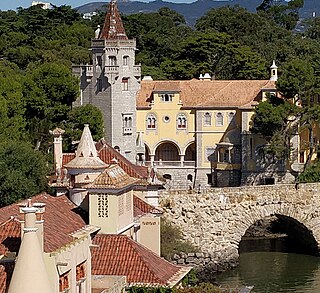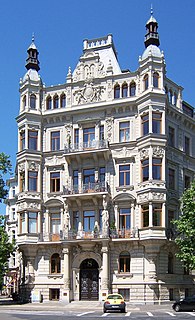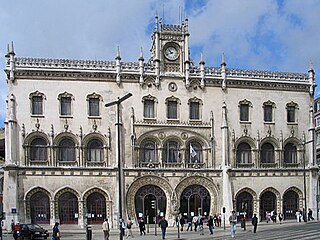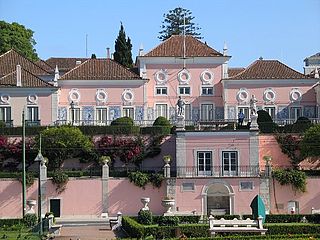
The Belém Palace, or alternately National Palace of Belém, has, over time, been the official residence of Portuguese monarchs and, after the installation of the First Republic, the Presidents of the Portuguese Republic. Located in the civil parish of Santa Maria de Belém, the palace is located on a small hill that fronts the Praça Afonso de Albuquerque, near the historical centre of Belém and the Monastery of the Jerónimos, close to the waterfront of the Tagus River. The five buildings that make up the main façade of the Palace date back to the second half of the 17th century, and were built at a time when the monarchy and nobility increasingly desired to seek respite from the urbanized confines of Lisbon.
Hugo José Jorge O'Neill, 4th Viscount of Santa Mónica was the head of the Clanaboy O'Neill dynasty, whose family has been in Portugal since the 18th century.
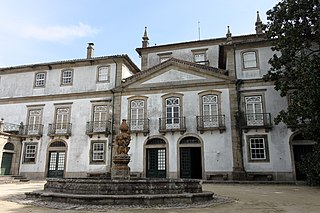
The Residence of Biscainhos, is a former-signeurial residence located in civil parish of Braga, in the municipality of Braga, in northern Portuguese district of Braga.

Braga is a civil parish in the municipality of Braga, Portugal. It was formed in 2013 by the merger of the former parishes Maximinos, Sé and Cividade. The population in 2011 was 14,572, in an area of 2.57 km².

The Palace of the Carrancas is a former-residence in the civil parish of Cedofeita, Santo Ildefonso, Sé, Miragaia, São Nicolau e Vitória, in the northern Portuguese city of Porto. It houses the Soares dos Reis National Museum.
The Roman villa of Outeiro de Polima ) is a Roman villa in the civil parish of São Domingos de Rana, in the Portuguese municipality of Cascais, dating from the 1st to 6th centuries AD.
The Ducal Palace of Vila Viçosa is a royal palace in Portugal, located in the civil parish of Nossa Senhora da Conceição, in the municipality of Vila Viçosa, in the Alentejo, situated about 150 km east of the capital Lisbon. It was for many centuries the seat of House of Braganza, one of the most important noble houses in Portugal which was the ruling house of the Kingdom of Portugal from 1640 until 1910 when King Manuel II, titular head of the family, was deposed in the 5 October 1910 Revolution which brought in a Republican government.

The Palace of Beau-Séjour is a 19th-century Portuguese manor house situated in the civil parish of São Domingos de Benfica, municipality of Lisbon.

The Palace of the Counts of Azambuja, alternately the Palace Valada-Azambuja is a 16th-century Portuguese estate manorhouse/palace situated in the civil parish of Misericórdia, municipality of Lisbon.
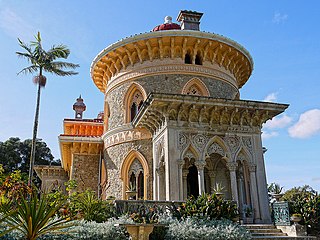
The Portuguese Riviera is the affluent coastal region to the west of Lisbon, Portugal, centered on the coastal cities of Cascais, Estoril, and Sintra. It is coterminous with the Estoril Coast and occasionally known as the Costa do Sol. The region is internationally known as a luxury destination for its history as a home of the wealthy, the famous, and European royalty.

The Palácio da Justiça is a historic building located in central Coimbra, Portugal, presently housing the city's Law Courts. It was formerly a religious house of the Dominican Order under the name College of St. Thomas and, whilst the private residence of the Counts of Ameal, was known as Palácio Ameal. Both of its former designations are still current in colloquial use.

The Museum of Portuguese Music is a small museum housed in the Casa Verdades de Faria in Estoril, municipality of Cascais, Portugal, on the Portuguese Riviera. It contains a collection of Portuguese musical instruments and other items, as well as a music documentation centre, and is also used for recitals.

The Palácio dos Condes da Guarda is located in Cascais, Lisbon District, Portugal. The building now functions both as the headquarters of the Municipality of Cascais and, on the ground floor, as a museum that explains the history of the town.

Palácio dos Bandeirantes is a palace in São Paulo, Brazil. It is the seat of the São Paulo state government and the governor's official residence. The palace, located at the Morumbi district, also houses some secretaries and a wide historical and artistic exhibition open to the public.

